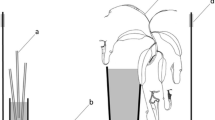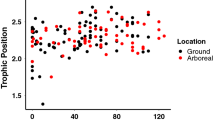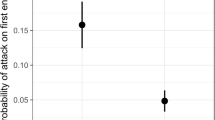Abstract
Meat ants (Iridomyrmex purpureus and allies) are perceived to be dominant members of Australian ant communities because of their great abundance, high rates of activity, and extreme aggressiveness. Here we describe the first experimental test of their influence on other ant species, and one of the first experimental studies of the influence of a dominant species on any diverse ant community. The study was conducted at a 0.4 ha savanna woodland site in the seasonal tropics of northern Australia, where the northern meat ant (I. sanguineus) represented 41% of pitfall catches and 73% of all ants at tuna baits, despite a total of 74 species being recorded. Meat ants were fenced out of experimental plots in order to test their influence on the foraging success of other species, as measured by access to tuna baits. The numbers of all other ants and ant species at baits in exclusion plots were approximately double those in controls (controlling for both the fences and for meat ant abundance), and returned rapidly to control levels when fences were removed after 7 weeks. Individual species differend markedly in their response to the fencing treatment, with species of Camponotus and Monomorium showing the strongest responses. Fencing had no effect on pitfall catches of species other than the meat ant, indicating that the effect of meat ants at baits was directly due to interference with foraging workers, and not regulation of general forager abundance. Such interference by meat ants has important implications for the sizes and densities of colonies of other ant species, and ultimately on overall ant community structure.
Similar content being viewed by others
References
Andersen AN (1986a) Diversity, seasonality and community organization of ants at adjacent heath and woodland sites in mesic southeastern Australia. Aust J Zool 34: 53–64
Andersen AN (1986b) Patterns of ant community organization in mesic southeastern Australia. Aust J Ecol 11: 87–99
Andersen AN (1988) Immediate and longer-term effects of fire on seed predation by ants in sclerophyllous vegetation of southeastern Australia. Aust J Ecol 13: 285–293
Andersen AN (1990) The use of ant communities to evaluate change in Australian terrestrial ecosystems: a review and a recipe. Proc Ecol Soc Aust 16: 347–357
Andersen AN (1991a) Parallels between ants and plants: implications for community ecology. In Huxley CR, Cutler DF (eds) Ant-plant interactions. Oxford University Press, Oxford pp 539–558
Andersen AN (1991b) Sampling communities of ground-foraging ants: pitfall catches compared with quadrat counts in an Australian tropical savanna. Aust J Ecol 16:273–279
Andersen AN (1991c) Responses of ground-foraging ant communities to three experimental fire regimes in a savanna forest of tropical Australia. Biotropica 23:575–585
Andersen AN (1991d) The ants of southern Australia: a guide to the Bassian fauna. CSIRO Press, Melbourne, Australia
Andersen AN (1992) Regulation of ‘momentary’ diversity by dominant species in exceptionally rich ant communities of the Australian seasonal tropics. Am Nat 140: 401–420
Andersen AN, Blum MS, Jones TM (1991) Venom alkaloids in Monomorium ‘rothsteini’ Forel repel other ants: is this the secret to success by Monomorium in Australian ant communities? Oecologia 88: 157–160
Bender EA, Case TJ, Gilpin ME (1984) Perturbation experiments in community ecology: theory and practice. Ecology 65: 1–13
Bennett WA (1990) Scale of investigation and the detection of competition: an example from the house sparrow and house finch introductions in North America. Am Nat 135: 725–747
Bond W, Slingsby P (1984) Collapse of an ant-plant mutualism: the Argentine ant (Iridomyrmex humilis) and myrmecochorous Proteaceae. Ecology 65: 1031–1037
Brian MV (1952) The structure of a dense natural ant population. J Anim Ecol 21: 12–24
Brian MV (1956) Segregation of species of the ant genus Myrmica. J Anim Ecol 25: 319–337
Briese DT, Macauley BJ (1980) Temporal structure of an ant community in semi-arid Australia. Aust J Ecol 5: 121–134
Christian KA, Morton SR (1992) Extreme thermophilia in a central Australian ant, Melophorus bagoti. Physiol Zool 65: 885–905
Cole BJ (1983) Assembly of mangrove ant communities: patterns of geographical distribution. J Anim Ecol 52: 339–347
Connell JH (1975) Some mechanisms producing structure in natural communities. In: Cody ML, Diamond JM (eds) Ecology and evolution of communities. Belknap Press, Cambridge, Mass, pp 460–490
Connell JH (1978) Diversity in tropical rainforests and coral reefs. Science 199: 1302–1310
Crowder MJ, Hand DJ (1990) Analysis of repeated measures. Chapman and Hall, London
Crowell KL (1968). Rates of competitive exclusion by the Argentine ant in Bermuda. Ecology 49: 551–555
Culver DC (1974) Species packing in Carribean and north temperate ant communities. Ecology 55: 974–988
Davidson DW (1985) An experimental study of diffuse competition in harvester ants. Am Nat 125: 500–506
Fellers JH (1987) Interference and exploitation in a guild of woodland ants. Ecology 68: 1466–1478
Fox MD, Fox BJ (1982). Evidence for interspecific competition influencing ant species diversity in a regenerating heathland. In: Buckley RC (ed) Ant-plant interactions in Australia. Junk Press, The Hague, pp 99–110
Fox BJ, Fox MD, Archer E (1985) Experimental confirmation of competition between two dominant species of Iridomyrmex (Hymenoptera: Formicidae). Aust J Ecol 10: 105–110
Gordon DM (1988) Nest-plugging: interference competition in desert ants (Novomessor cockerelli and Pogonomyrmex barbatus). Oecologia 75: 114–118
Gordon DM (1991) Variation and change in behavioural ecology. Ecology 72: 1196–1203
Greenslade PJM (1971) Interspecific competition and frequency changes among ants in Solomon Islands coconut plantations. J Appl Ecol 8: 323–352
Greenslade PJM (1973) Sampling ants with pitfall traps: diggingin effects. Insectes Sociaux 20: 343–353
Greenslade PJM (1976) The meat ant Iridomyrmex purpureus (Hymenoptera: Formicidae) as a dominant member of ant communities. J Aust Ent Soc 15: 237–240
Greenslade PJM (1978) Ants. In: Low WA (ed) The physical and biological features of Kunoth Paddock in Central Australia. CSIRO Division of Land Resources Management Technical Paper No. 4, pp 109–113
Greenslade PJM (1979) A guide to ants of South Australia. South Australian Museum, Adelaide, Australia
Greenslade PJM, Halliday RB (1982) Distribution and speciation in meat ants, Iridomyrmex purpureus and related species (Hymenoptera: Formicidae). In: Barker WR, Greenslade PJM (eds) Evolution of the flora and fauna of arid Australia. Peacock Publications, Adelaide, pp 249–255
Greenslade PJM, Halliday RB (1983) Colony dispersion and relationships of meat ants Iridomyrmex purpureus and allies in an arid locality in South Australia. Insectes Sociaux 30: 82–99
Grime JP (1973) Plant strategies and vegetation processes. Wiley, Chichester
Haskins CP, Haskins EF (1988) Final observations on Pheidole megacephala and Iridomyrmex humilis in Bermuda. Psyche 95: 177–184
Hölldobler B, (1976) Recruitment behaviour, home range orientation and territoriality in harvester ants, Pogonomyrmex. Behav Ecol Sociobiol 1: 3–44
Hölldobler B (1986) Food robbing in ants, a form of interference competition. Oecologia 69: 12–15
Hölldobler B, Wilson EO (1990) The ants. Belknap Press, Cambridge, Mass.
Holt JA (1990) Observations on the relationships between meat ants and termites in tropical Australia. J Trop Ecol 6: 379–382
Hurlbert SH (1984) Pseudoreplication and the design of ecological field experiments. Ecol Monogr 54: 187–211
Kugler C (1984) Ecology of the ant Pogonomyrmex mayri: foraging and competition. Biotropica 16: 227–234
Levings SC (1982) Patterns of nest dispersion in a tropical ground ant community. Ecology 63: 338–344
Levings SC, Traniello JFA (1981) Territoriality, nest dispersion, and community structure in ants. Psyche 88:265–319
Lynch JF, Balinsky EC, Vail SG (1980) Foraging patterns in three sympatric forest ant species, Prenolepis imparis, Paratrechina melanderi and Aphaenogaster rudis (Hymenoptera: Formicidae). Ecol Entomol 5: 353–371
Majer JD (1976) The maintenance of the ant mosaic in Ghana cocoa farms. J Appl Ecol 13: 123–144
Majer JD (1985) Recolonization by ants of rehabilitated mineral sand mines on North Stradbroke Island, Queensland, with particular reference to seed removal. Aust J Ecol 10: 31–48
Moermond TC (1986) A mechanistic approach to the structure of animal communities: Anolis lizards and birds. Am Zool 26: 23–37
Pontin AJ (1963) Further considerations of competition and the ecology of the ants Lasius flavus (F.) and L. niger (L.). J Anim Ecol 32: 565–574
Porter SD, Savignano DA (1990) Invasion of polygyne fire ants decimates native ants and disrupts arthropod community. Ecology 71: 2095–2106
Rosengren R (1986) Competition and coexistence in an insular ant community-a manipulation experiment (Hymenoptera: Formicidae). Ann Zool Fenn 23: 297–302
Roughgarden J (1983) Competition and theory in community ecology. Am Nat 122: 583–601
Savolainen R (1990) Colony success of the submissive ant Formica fusca within territories of the dominant Formica polyctena. Ecol Entomol 15: 1–10
Savolainen R (1991) Interference by wood ant influences size selection and retrieval rate of prey by Formica fusca. Behav Ecol Sociobiol 28: 1–7
Savolainen R, Vepsäläinen K (1988) A competition hierarchy among boreal ants: impact on resource partitioning and community structure. Oikos 51: 135–155
Savolainen R, Vepsäläinen K (1989) Niche differentiation of ant species within territories of the wood ant Formica polyctena. Oikos 56: 3–16
Shattuck SO (1992) Generic revision of the ant subfamily Dolichoderinae (Hymenoptera: Formicidae). Sociobiology 21: 1–181
Shorrocks B, Rosewell J, Edwards K (1984). Interspecific competition is not a major organizing force in many insect communities. Nature 310: 310–312
Simberloff D (1983) Competition theory, hypothesis-testing and other community ecological buzzwords. Am Nat 122: 626–635
Stone L, Roberts A (1991) Conditions for a species to gain advantage from the presence of competitors. Ecology 72: 1964–1972
Strong DR (1984) Exorcising the ghost of competition past: phytophagous insects. In: Strong DR, Simberloff D, Abele LG, Thistle AB (eds) Ecological communities-conceptual issues and the evidence. Princeton University Press, Princeton, pp 28–41
Taylor RW, Brown DR (1985) Formicoidea. In: Walton DW (ed) Zoological catalogue of Australia, vol. 2. Hymenoptera: Formicoidea, Vespoidea and Sphecoidea. Australian Government Publishing Service, Canberra pp 1–149
Tilman D (1982) Resource competition and community structure. Princeton University Press, Princeton
Torres JA (1984) Niches and coexistence of ant communities in Puerto Rico: repeated patterns. Biotropica 16: 284–295
Vepsäläinen K, Pisarski B (1982) Assembly of island ant communities. Ann Zool Fenn 19: 327–335
Vepsäläinen K, Savolainen R (1990) The effect of interference by formicine ants on the foraging of Myrmica. J Anim Ecol 59: 643–654
Wilson EO and Taylor RW (1967) The ants of Polynesia (Hymenoptera: Formicidae). Pac Insects Monogr 14: 1–109
Wise DH (1984) The role of competition in spider communities: insights from field experiments with a model organism. In: Strong DR, Simberloff D, Abele LG, Thistle AB (eds) Ecological communities-conceptual issues and the evidence. Princeton University Press, Princeton, pp 42–52
Author information
Authors and Affiliations
Rights and permissions
About this article
Cite this article
Andersen, A.N., Patel, A.D. Meat ants as dominant members of Australian ant communities: an experimental test of their influence on the foraging success and forager abundance of other species. Oecologia 98, 15–24 (1994). https://doi.org/10.1007/BF00326085
Received:
Accepted:
Issue Date:
DOI: https://doi.org/10.1007/BF00326085




